CRJ4001 Victimology: Domestic Abuse, Linda's Case, and Support Systems
VerifiedAdded on 2023/04/25
|6
|1139
|124
Report
AI Summary
This report analyzes the case of Linda, a victim of domestic abuse, exploring the support systems available to her, including organizations like the Asian & Pacific Islander Institute and the American Bar Association. It examines the application of the 'Learned Helplessness' theory to Linda's situation, explaining why she remains in the abusive relationship despite the violence she and her son endure. The report delves into Linda's financial dependence, fear of retribution, and societal pressures as factors influencing her decisions. Furthermore, it discusses the ethical considerations of blaming Linda for not protecting her child, emphasizing her fiduciary duty and the complex reasons why she cannot simply leave the situation. The report concludes by highlighting the challenges faced by victims of domestic abuse and the importance of understanding their circumstances. It includes relevant references in APA format, providing a comprehensive analysis of the case.
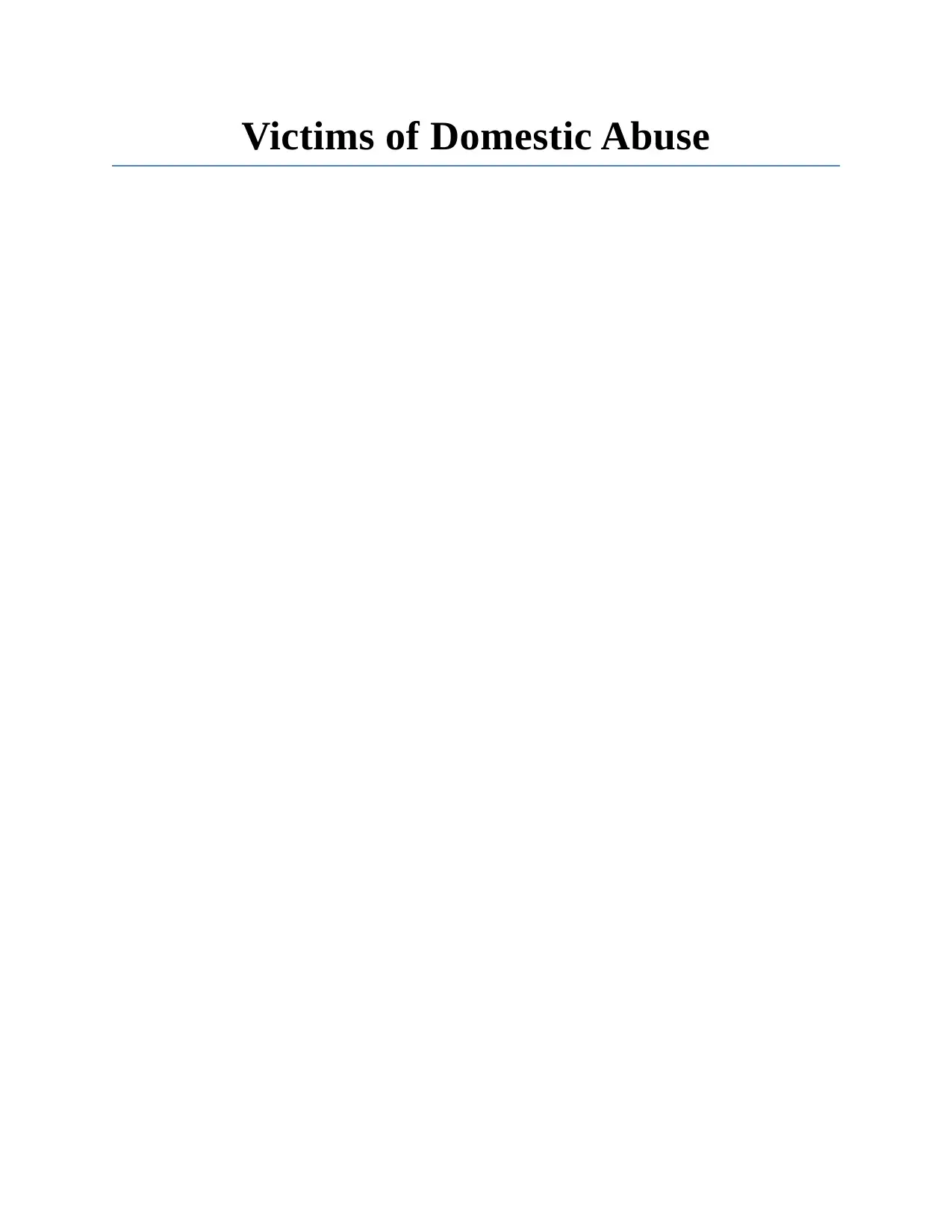
Victims of Domestic Abuse
Paraphrase This Document
Need a fresh take? Get an instant paraphrase of this document with our AI Paraphraser
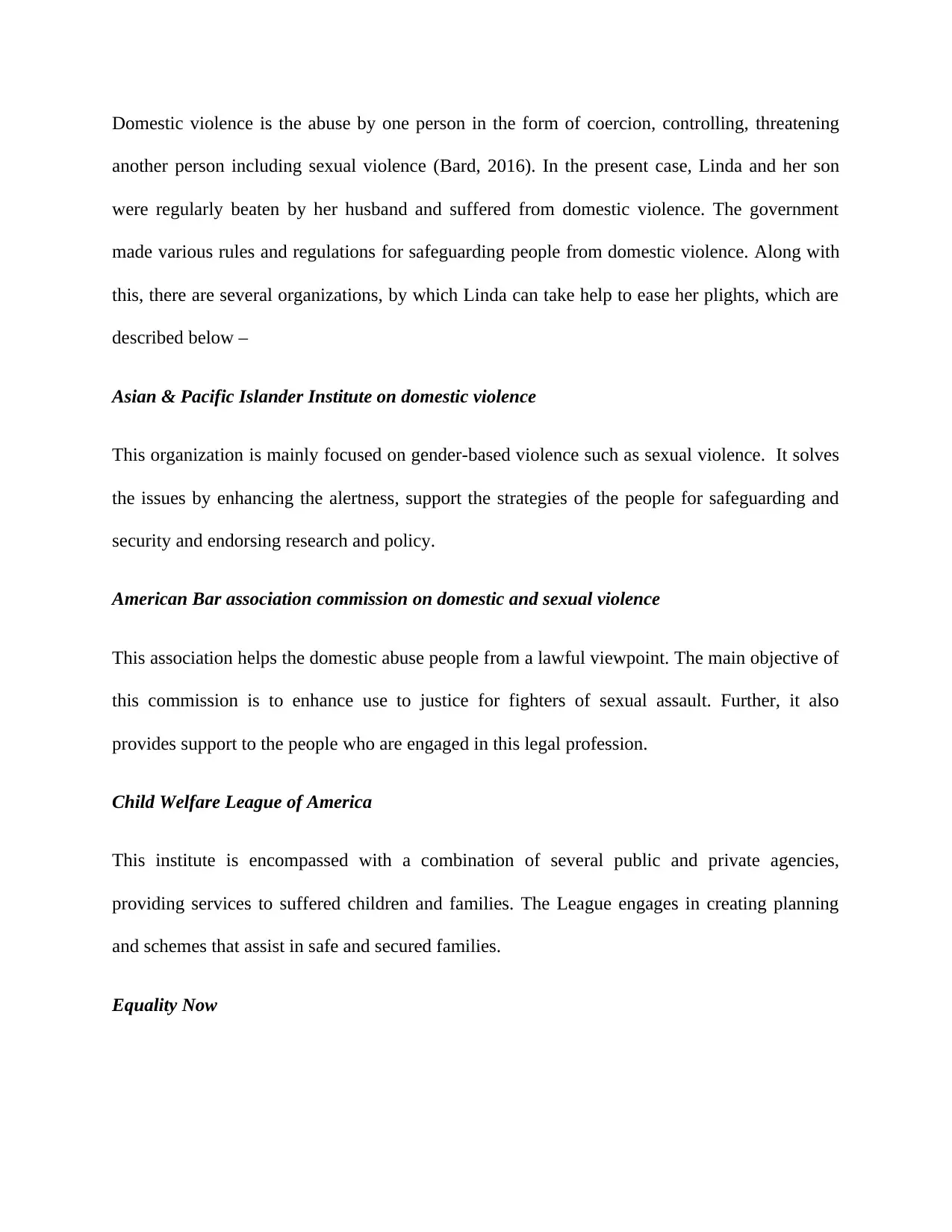
Domestic violence is the abuse by one person in the form of coercion, controlling, threatening
another person including sexual violence (Bard, 2016). In the present case, Linda and her son
were regularly beaten by her husband and suffered from domestic violence. The government
made various rules and regulations for safeguarding people from domestic violence. Along with
this, there are several organizations, by which Linda can take help to ease her plights, which are
described below –
Asian & Pacific Islander Institute on domestic violence
This organization is mainly focused on gender-based violence such as sexual violence. It solves
the issues by enhancing the alertness, support the strategies of the people for safeguarding and
security and endorsing research and policy.
American Bar association commission on domestic and sexual violence
This association helps the domestic abuse people from a lawful viewpoint. The main objective of
this commission is to enhance use to justice for fighters of sexual assault. Further, it also
provides support to the people who are engaged in this legal profession.
Child Welfare League of America
This institute is encompassed with a combination of several public and private agencies,
providing services to suffered children and families. The League engages in creating planning
and schemes that assist in safe and secured families.
Equality Now
another person including sexual violence (Bard, 2016). In the present case, Linda and her son
were regularly beaten by her husband and suffered from domestic violence. The government
made various rules and regulations for safeguarding people from domestic violence. Along with
this, there are several organizations, by which Linda can take help to ease her plights, which are
described below –
Asian & Pacific Islander Institute on domestic violence
This organization is mainly focused on gender-based violence such as sexual violence. It solves
the issues by enhancing the alertness, support the strategies of the people for safeguarding and
security and endorsing research and policy.
American Bar association commission on domestic and sexual violence
This association helps the domestic abuse people from a lawful viewpoint. The main objective of
this commission is to enhance use to justice for fighters of sexual assault. Further, it also
provides support to the people who are engaged in this legal profession.
Child Welfare League of America
This institute is encompassed with a combination of several public and private agencies,
providing services to suffered children and families. The League engages in creating planning
and schemes that assist in safe and secured families.
Equality Now
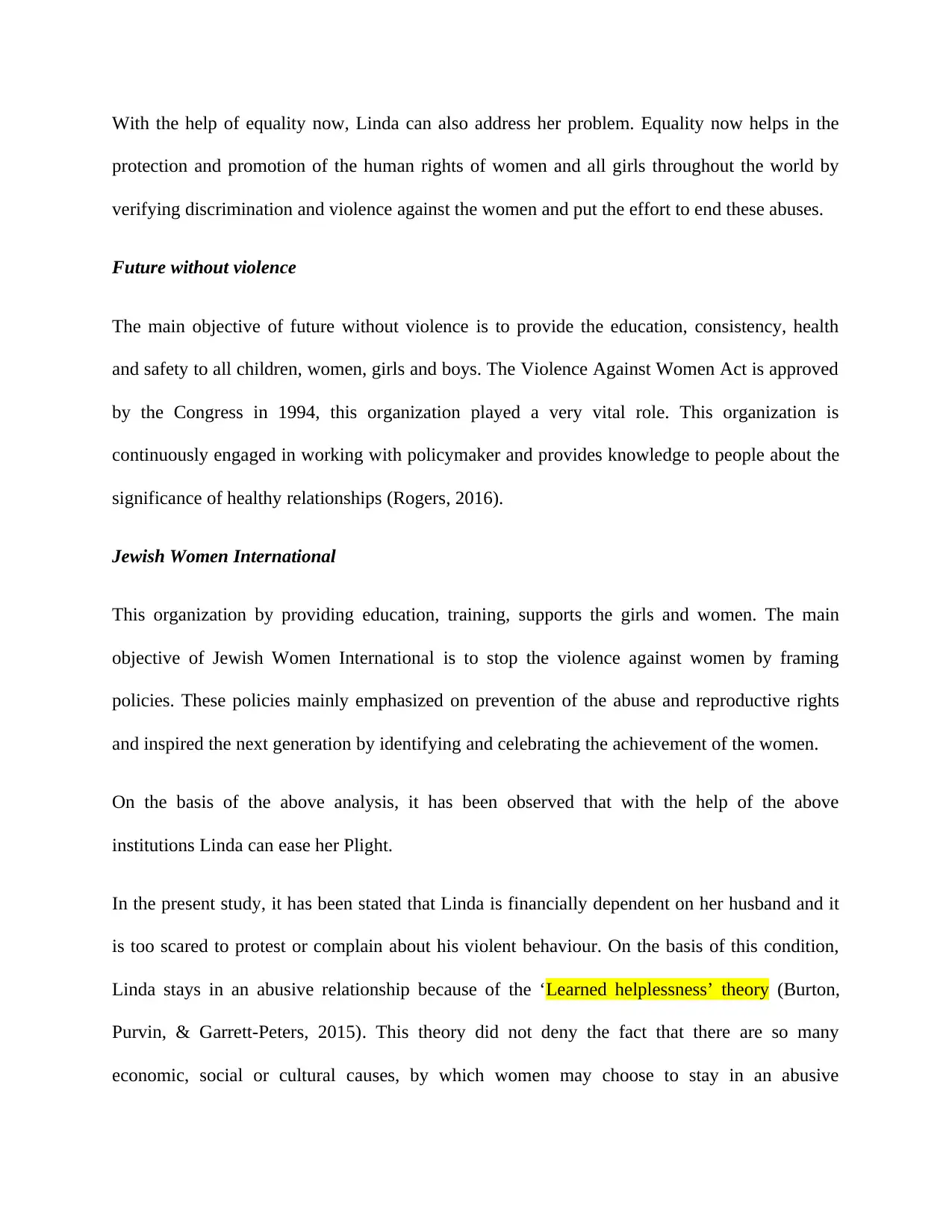
With the help of equality now, Linda can also address her problem. Equality now helps in the
protection and promotion of the human rights of women and all girls throughout the world by
verifying discrimination and violence against the women and put the effort to end these abuses.
Future without violence
The main objective of future without violence is to provide the education, consistency, health
and safety to all children, women, girls and boys. The Violence Against Women Act is approved
by the Congress in 1994, this organization played a very vital role. This organization is
continuously engaged in working with policymaker and provides knowledge to people about the
significance of healthy relationships (Rogers, 2016).
Jewish Women International
This organization by providing education, training, supports the girls and women. The main
objective of Jewish Women International is to stop the violence against women by framing
policies. These policies mainly emphasized on prevention of the abuse and reproductive rights
and inspired the next generation by identifying and celebrating the achievement of the women.
On the basis of the above analysis, it has been observed that with the help of the above
institutions Linda can ease her Plight.
In the present study, it has been stated that Linda is financially dependent on her husband and it
is too scared to protest or complain about his violent behaviour. On the basis of this condition,
Linda stays in an abusive relationship because of the ‘Learned helplessness’ theory (Burton,
Purvin, & Garrett-Peters, 2015). This theory did not deny the fact that there are so many
economic, social or cultural causes, by which women may choose to stay in an abusive
protection and promotion of the human rights of women and all girls throughout the world by
verifying discrimination and violence against the women and put the effort to end these abuses.
Future without violence
The main objective of future without violence is to provide the education, consistency, health
and safety to all children, women, girls and boys. The Violence Against Women Act is approved
by the Congress in 1994, this organization played a very vital role. This organization is
continuously engaged in working with policymaker and provides knowledge to people about the
significance of healthy relationships (Rogers, 2016).
Jewish Women International
This organization by providing education, training, supports the girls and women. The main
objective of Jewish Women International is to stop the violence against women by framing
policies. These policies mainly emphasized on prevention of the abuse and reproductive rights
and inspired the next generation by identifying and celebrating the achievement of the women.
On the basis of the above analysis, it has been observed that with the help of the above
institutions Linda can ease her Plight.
In the present study, it has been stated that Linda is financially dependent on her husband and it
is too scared to protest or complain about his violent behaviour. On the basis of this condition,
Linda stays in an abusive relationship because of the ‘Learned helplessness’ theory (Burton,
Purvin, & Garrett-Peters, 2015). This theory did not deny the fact that there are so many
economic, social or cultural causes, by which women may choose to stay in an abusive
⊘ This is a preview!⊘
Do you want full access?
Subscribe today to unlock all pages.

Trusted by 1+ million students worldwide
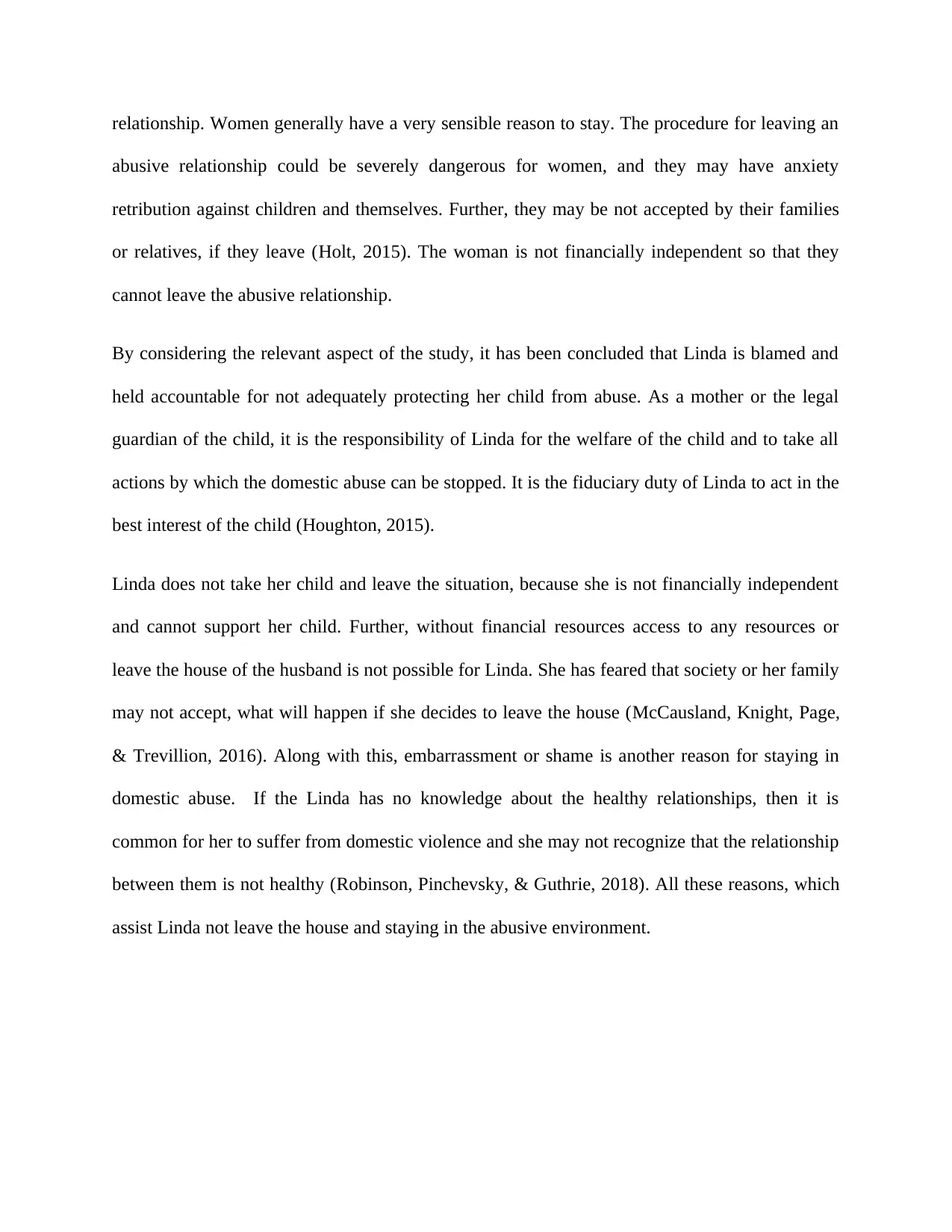
relationship. Women generally have a very sensible reason to stay. The procedure for leaving an
abusive relationship could be severely dangerous for women, and they may have anxiety
retribution against children and themselves. Further, they may be not accepted by their families
or relatives, if they leave (Holt, 2015). The woman is not financially independent so that they
cannot leave the abusive relationship.
By considering the relevant aspect of the study, it has been concluded that Linda is blamed and
held accountable for not adequately protecting her child from abuse. As a mother or the legal
guardian of the child, it is the responsibility of Linda for the welfare of the child and to take all
actions by which the domestic abuse can be stopped. It is the fiduciary duty of Linda to act in the
best interest of the child (Houghton, 2015).
Linda does not take her child and leave the situation, because she is not financially independent
and cannot support her child. Further, without financial resources access to any resources or
leave the house of the husband is not possible for Linda. She has feared that society or her family
may not accept, what will happen if she decides to leave the house (McCausland, Knight, Page,
& Trevillion, 2016). Along with this, embarrassment or shame is another reason for staying in
domestic abuse. If the Linda has no knowledge about the healthy relationships, then it is
common for her to suffer from domestic violence and she may not recognize that the relationship
between them is not healthy (Robinson, Pinchevsky, & Guthrie, 2018). All these reasons, which
assist Linda not leave the house and staying in the abusive environment.
abusive relationship could be severely dangerous for women, and they may have anxiety
retribution against children and themselves. Further, they may be not accepted by their families
or relatives, if they leave (Holt, 2015). The woman is not financially independent so that they
cannot leave the abusive relationship.
By considering the relevant aspect of the study, it has been concluded that Linda is blamed and
held accountable for not adequately protecting her child from abuse. As a mother or the legal
guardian of the child, it is the responsibility of Linda for the welfare of the child and to take all
actions by which the domestic abuse can be stopped. It is the fiduciary duty of Linda to act in the
best interest of the child (Houghton, 2015).
Linda does not take her child and leave the situation, because she is not financially independent
and cannot support her child. Further, without financial resources access to any resources or
leave the house of the husband is not possible for Linda. She has feared that society or her family
may not accept, what will happen if she decides to leave the house (McCausland, Knight, Page,
& Trevillion, 2016). Along with this, embarrassment or shame is another reason for staying in
domestic abuse. If the Linda has no knowledge about the healthy relationships, then it is
common for her to suffer from domestic violence and she may not recognize that the relationship
between them is not healthy (Robinson, Pinchevsky, & Guthrie, 2018). All these reasons, which
assist Linda not leave the house and staying in the abusive environment.
Paraphrase This Document
Need a fresh take? Get an instant paraphrase of this document with our AI Paraphraser
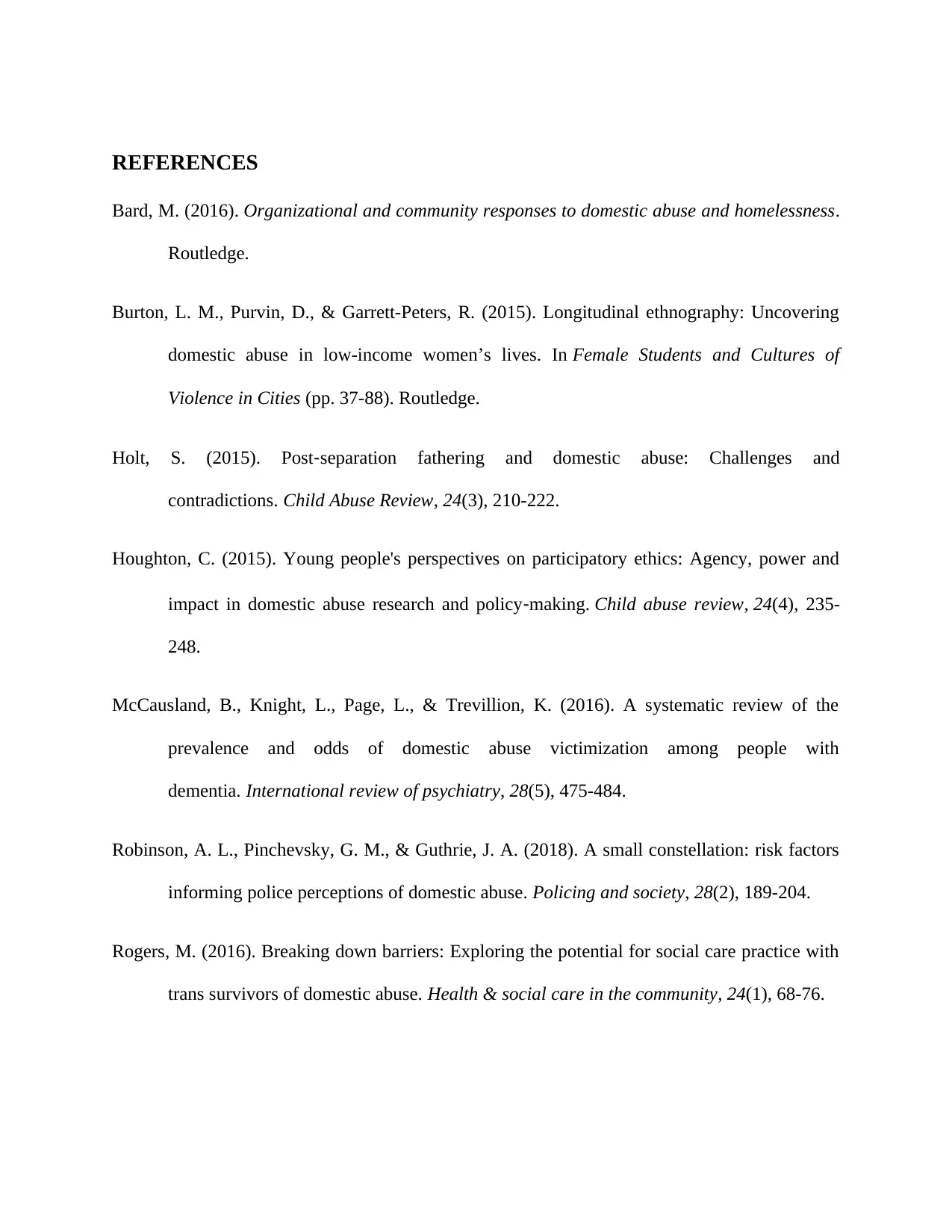
REFERENCES
Bard, M. (2016). Organizational and community responses to domestic abuse and homelessness.
Routledge.
Burton, L. M., Purvin, D., & Garrett-Peters, R. (2015). Longitudinal ethnography: Uncovering
domestic abuse in low-income women’s lives. In Female Students and Cultures of
Violence in Cities (pp. 37-88). Routledge.
Holt, S. (2015). Post‐separation fathering and domestic abuse: Challenges and
contradictions. Child Abuse Review, 24(3), 210-222.
Houghton, C. (2015). Young people's perspectives on participatory ethics: Agency, power and
impact in domestic abuse research and policy‐making. Child abuse review, 24(4), 235-
248.
McCausland, B., Knight, L., Page, L., & Trevillion, K. (2016). A systematic review of the
prevalence and odds of domestic abuse victimization among people with
dementia. International review of psychiatry, 28(5), 475-484.
Robinson, A. L., Pinchevsky, G. M., & Guthrie, J. A. (2018). A small constellation: risk factors
informing police perceptions of domestic abuse. Policing and society, 28(2), 189-204.
Rogers, M. (2016). Breaking down barriers: Exploring the potential for social care practice with
trans survivors of domestic abuse. Health & social care in the community, 24(1), 68-76.
Bard, M. (2016). Organizational and community responses to domestic abuse and homelessness.
Routledge.
Burton, L. M., Purvin, D., & Garrett-Peters, R. (2015). Longitudinal ethnography: Uncovering
domestic abuse in low-income women’s lives. In Female Students and Cultures of
Violence in Cities (pp. 37-88). Routledge.
Holt, S. (2015). Post‐separation fathering and domestic abuse: Challenges and
contradictions. Child Abuse Review, 24(3), 210-222.
Houghton, C. (2015). Young people's perspectives on participatory ethics: Agency, power and
impact in domestic abuse research and policy‐making. Child abuse review, 24(4), 235-
248.
McCausland, B., Knight, L., Page, L., & Trevillion, K. (2016). A systematic review of the
prevalence and odds of domestic abuse victimization among people with
dementia. International review of psychiatry, 28(5), 475-484.
Robinson, A. L., Pinchevsky, G. M., & Guthrie, J. A. (2018). A small constellation: risk factors
informing police perceptions of domestic abuse. Policing and society, 28(2), 189-204.
Rogers, M. (2016). Breaking down barriers: Exploring the potential for social care practice with
trans survivors of domestic abuse. Health & social care in the community, 24(1), 68-76.

⊘ This is a preview!⊘
Do you want full access?
Subscribe today to unlock all pages.

Trusted by 1+ million students worldwide
1 out of 6
Your All-in-One AI-Powered Toolkit for Academic Success.
+13062052269
info@desklib.com
Available 24*7 on WhatsApp / Email
![[object Object]](/_next/static/media/star-bottom.7253800d.svg)
Unlock your academic potential
Copyright © 2020–2025 A2Z Services. All Rights Reserved. Developed and managed by ZUCOL.


